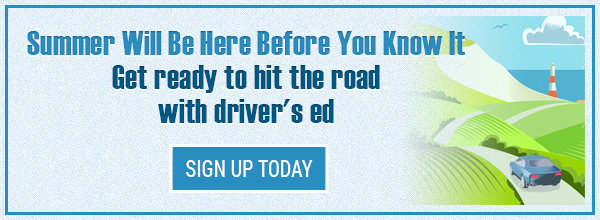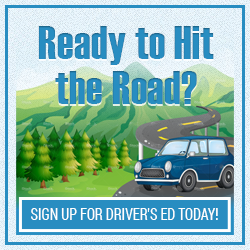.png?width=640&name=things-the-dont-teach-you-in-other-driving-schools%20(1).png)
Good sense and sound judgment often referred to as “common sense” can be taught and learned. But common sense lessons are not necessarily common among driving institutions teaching driver’s education. Most driving schools only cover the basics.
Teen drivers have a lot to learn outside the basics, and Western Slope Driving Institute tackles common sense items that other driving schools do not. The following are just a few of them.
1) Turn off your hi-beams.
A study by the National Highway Traffic Safety Administration (NHTSA) pegged the nighttime driving fatality rate at three times higher than the daytime rate. The reason is apparent: Night driving conditions are different from daytime driving. Because of lack of light, drivers have limited depth perception and peripheral vision. Not to mention, after a full day of hard work, fatigue can easily sleep in at night.
High beams are useful and can save lives on unlit or inadequately lit roads, but they can also blind oncoming traffic on well-lit roads and result in a head-on collision. High beams can have a similar effect on the driver ahead of you. You will likely end up rear-ending them if they crash.
If your car comes with rear fog lights, remember to only use them in foggy conditions - hence, the name - or when visibility is zero because of a heavy thunderstorm. If driving conditions are good, do not turn them on because they can also temporarily impair the vision of the driver behind you.
2) Understand what ABS is and how it can keep you safe.
An anti-lock braking system (ABS) is exactly what it says it is - a safety system that prevents wheel lockup during heavy braking, hence keeping road traction and preventing uncontrolled skidding. A vehicle equipped with ABS maintains steerability while braking, allowing drivers to steer around a road block instead of directly colliding with it.
While ABS does not generally allow you to stop faster, it helps you:
- Avoid hitting the object that caused you to brake
- Maintain tire traction on slippery or wet roads
- Corner more quickly and safely
- Prevent high-sided vehicles, such as lorries and vans, from being blown over when driving in high winds
3) Use your signals.
When driving, the only ways you can communicate with other drivers are through audible and visible signals. As such, never forget to use your car’s signals at least five seconds before you make a left or right turn. This is to let other drivers know of your intention, and they can slow down or give way as necessary.
However, signaling is never intended for any driver to abuse. Do not use your car’s signaling mechanisms to command other drivers to do your bidding. In other words, do not expect them to make way when making a lane change on the freeway or at an intersection. Other drivers may not see your signal, while others may have no intentions of acting on it.
If you cause an accident, saying “But I signaled, Officer” to the apprehending traffic enforcer, they won’t let you off the hook.
While still on the subject of audible signals, also keep in mind that your car’s horn should only be used to alert people to danger, not for venting your anger.
4) Do not multitask, such as text and drive.
The National Safety Council is putting its foot down on multitasking once and for all. In its infographic entitled “The Great Multitasking Lie,” it echoes what brain experts have been saying for years:
- The human brain cannot do two things at the same time. When the brain switches between two tasks, it slows down reaction time.
- Drivers talking on their phones can miss seeing up to 50% of their driving environments, including red lights and pedestrians, which makes hands-free phone usage just as dangerous as texting while driving.
Whenever you are out driving, always keep the following three things in mind: your eyes on the road, your hands on the wheel, and your mind on driving. Leaving out one imperils not just yourself but others on the road as well.
5) Green lights are not always a go.
When the light goes green at the intersection, it simply means it’s legal to go but not necessarily safe. Remember to always physically check every intersection before you drive ahead.
6) Be courteous.
If there is anything that will make the roads safer for everyone, it is road courtesy.
Some ways to manifest road courtesy:
- Do not tailgate. You know you are keeping a safe distance when you see the rear tires of the car ahead of you. This allows you enough time to think and room to maneuver if sudden changes occur.
- Keep calm. Being on the road with a license or driver’s permit does not make you special. If other drivers insist on passing you, then let them pass you. A bad situation can still get you killed even when you are in the right.
- The left lane is for passing. Keep the left lane open for passing or overtaking vehicles. It is not for slow-moving vehicles to drive on.
- Do not underestimate the power of a wave. A simple wave can mean “I am sorry” or “Thank you” depending on the circumstance and has the potential to prevent a bad situation from getting worse.
- Do not cause a traffic jam by letting others in. While giving way may seem like you are being nice, it can hold up traffic and get you rear-ended.
- Do not stop and stare. Do not cause a traffic situation by stopping and staring at accidents or a motorist on the side of the road who does not need your help.
Final word
Your teen driver’s inexperience is the perfect teaching condition for inculcating in them not just the rudiments of defensive driving but common sense items that will keep them safe on the road.
If you need help from the experts, Western Slope Driving Institute’s instructors are former first responders, law enforcement professionals, and armed forces personnel who use real-life experiences to teach teen drivers how to become better and safer drivers. Give us a call today to sign up your teenager in any of our driving courses.


